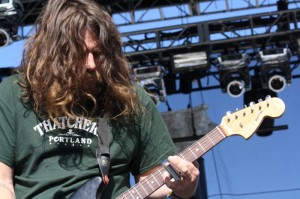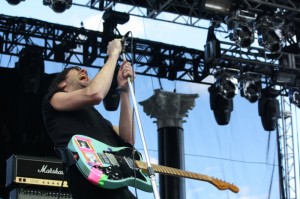Everyone has a habit. For many music fans, the one they can’t seem to shake is attending massive festivals. Coachella. Bonnaroo. Bumbershoot. Sasquatch. These are all established music festivals that draw tens of thousands every year. They’re physically and financially taxing and feature countless artists in often-conflicting time slots. The talent play festivals because they find it difficult turning down an opportunity to expose themselves to a larger audience. Plus, under the right circumstances, they can be fun as hell to play.
Not everyone can afford to go to big music festivals like Coachella in Palm Springs, Bonnaroo in Tennessee, and Sasquatch, which takes place closer to home at the Gorge Ampitheatre, a couple hours east of Seattle, WA. But those who do attend get a mixed bag of artists to choose from, unpredictable outdoor weather and sound conditions, and an experience they can talk about until the next music festival comes along. Those playing the festivals usually roll in and out of the sites, secretly hoping their short time on stage will be somehow transcendent and not end in total disaster, and that they’ll come away with a smattering of new fans.

The 24,000-plus who attended the recent Sasquatch Festival each left the battered Gorge campgrounds with their own impressions, good and bad. Some finally saw their favourite band play at the stunning Gorge Ampitheatre main stage (Macklemore, Arctic Monkeys, Bloc Party, Sigur Ros, and Mumford and Sons were highlights), just as the sun went down over the Columbia River. Others were exposed to amazing bands on the number of side-stages; bands they would search out after the festival was over and add to their playlists.
And, of course, some festival attendees would walk away from Sasquatch disgruntled; complaining about bad sound, not being able to see everyone they wanted to, an ultimately weak lineup, or those loud camping neighbours who wouldn’t let them sleep all weekend. Artists (hopefully fed and paid well) would leave Sasquatch with the same mixed results.
Yes, the model of cramming as many bands onto as many stages for as many days as possible is flourishing. The question is this: are mainstream rock festivals good or bad for music?
Do they strengthen the music scene and expose more people to more bands? Or does the whole experience of seeing hundreds of bands over the course of a weekend cheapen the experience, watering down the music scene by applying a lowest common denominator to sound, talent, and logistics?
Bigfoot vs. Sasquatch
Sasquatch’s second stage, aptly titled the Bigfoot stage, features big-name acts throughout the festival. When everything is in synch, it sounds and looks amazing: a perfect place for a medium-sized act to raise their profile, or for an established band like Primus (who closed one night with their amazing 3D show this year) to prove that they still deserve to be playing to huge outdoor crowds.
But when festival sound goes bad, it can be a complete disaster for artists. Much-anticipated sets by the likes of Grimes, Tame Impala (who were forced to move to a different stage), Earl Sweatshirt, and The Japandroids were rendered inaudible by bad sound and even worse recovery times.
“We couldn’t hear ourselves in the monitors at all,” says Japandroids vocalist/guitarist Brian King after their disappointing set. “It was really frustrating because we’ve been looking forward to playing Sasquatch.”
Sasquatch festival organizers spend every waking moment leading up to the festival to ensure that everything runs smoothly. Which makes you wonder why the festival’s second-largest stage could sound so bad, while the flagship main stage was practically flawless in its execution.
And then there’s a festival’s lineup. Often a mixed bag of reliable headliners, buzz bands, and some homegrown talent, the process of solidifying a festival lineup like Sasquatch’s is a full-time job. There’s no way to please everyone, the result being the classic case of trying to make everyone happy with big-name acts that appeal to the masses and smaller, up-and-coming bands who may have developed some chatter around a hit song or two. Yes, the “Harlem Shake” guy played Sasquatch this year: anything to make that lineup just a little more appealing for ticket buyers.
How did we get here?
Portland rock/metal band Red Fang made the best of their 5 pm slot on the opening day of Sasquatch. Before the sound on the Bigfoot stage took a huge dump for the rest of the weekend, these hirsute rockers pounded out a set of mostly new material on an unsuspecting festival crowd.
“It’s a little less stressful playing a festival because we can just say, ‘Fuck it, let’s try out some new shit. And if we fuck it up, they won’t know, because they’ve never heard us before,’” says Red Fang drummer John Sherman.
Despite the non-traditional outdoor environment for a band that’s used to playing dingy, dark clubs, Red Fang have gotten over their initial trepidation of playing large outdoor festivals. With a sound that is pure animalistic power, the band wins over new fans every time they play another festival: like the guy that ran over to the band’s merch booth after their show, bought a T-shirt, and didn’t take it off the whole weekend.
“When we first started doing bigger festivals we were scared because we were playing in the sunlight,” jokes Sherman, “but it’s actually fucking great because you get to play in front of a lot more people than you normally would, because it’s not just your fans, it’s everyone, so you get exposed to new people.”
Unlike some acts that could suffer from an evening time slot, Red Fang take an early set time as a challenge and see it as an opportunity rather than a burden.
“A 5 pm set? Ah man, that’s nothing,” says Sherman. “We just played a festival in Europe where our set was 11:20 am to noon. We were done at noon.”
Attention Deficit Fest 2013
Akron/Family drummer Dayna Janssen admits that his experimental band needs to dumb down its sound, or at least its song choices, a little in order to play a festival like Sasquatch. The notoriously all-over-the-place band can’t exactly bust out a set of folk-noise like they would in a metro-area club, but they can do their best to grab the attention of a guy in a bear suit on his way to the beer garden, or that group of costumed festival warriors walking past on their way to the mainstage.
“Festivals are very short attention span, by nature, so I feel like you have to capture people as best you can with energy,” says Janssen, “because people are so excited to see all the bands that they like.”
Bands such as Akron/Family are a bit too weird to appeal to the masses, and that’s how they seem to like it, but it creates a situation where they can’t truly be themselves on a festival stage. Most bands play it safe when they get booked to play big festivals, but the only way a band like Akron/Family can really get noticed is by balancing the noisier, more experimental aspects of their sound with something that festival goers can latch on to.
“It’s so much easier when people know your songs, versus trying to convince people that you’re valid,” explains Janssen. “We’re not a hip band, we’re not the youngest, most attractive people in the world, you know, so it’s the music that speaks for itself.”
Risk rewards
Minneapolis rapper P.O.S. (real name: Stefon Alexander) was one of a number of really great hip-hop artists to play Sasquatch this year. Sasquatch devotes an entire stage (albeit the much smaller Cthtulu stage) to hip-hop and highlighted rap artists such as Killer Mike, Death Grips, and Earl Sweatshirt on their bigger stages.
Macklemore and Ryan Lewis, one of the world’s biggest hip-hop artists, closed the main stage on opening night.
Perhaps the key to valuable music festivals could be taking these kinds of risks. By putting together more eclectic bills and mixing musical genres, festival organizers can feel they are providing interesting options. For every radio-fed mob there to see Macklemore, maybe a few people will latch onto someone like P.O.S.
“A lot of it was trying to catch people and bring them in,” says P.O.S. after his rousing afternoon set. “So you have some people at first, and their energy is going to draw more and more people in, and it changes the dynamic by the end of the show. It’s a lot of fun.”

Fresh from a sold-out rap festival in Minneapolis, P.O.S.’ set at Sasquatch was proof of how mainstream music festivals can be a valuable entry point to richer, and more underground, music scenes.
“It’s easy to gauge your audience at a club, because you look out at the room and base it on the capacity, it either fills up or it doesn’t fill up,” explains P.O.S. “But a festival is more of a nebulous thing. Someone might just walk by and hear a beat and they might like it.”
Death Grips, an experimental hip-hop group from Sacramento, commanded the audience on the last day of Sasquatch. Uncompromising, dangerous, and scary, they were the kind of festival act that you can’t look away from.
Want the kind of adrenaline rush of a group like Death Grips to last a whole festival? Go to a genre-specific festival like Rock the Bells (rap), The Fest (punk), or Heavy MTL (metal). But that’s not the point of bigger music festivals.
Mainstream festivals aren’t ruining music: they’re just appealing to its universal nature. And perhaps something for everyone, in the context of the 24,000-plus that attended Sasquatch, makes perfect sense when compared to the option of everything for someone.
